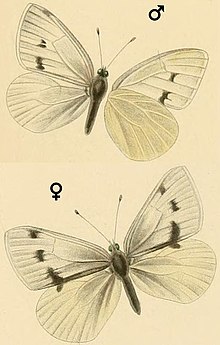en
names in breadcrumbs


Pieris, the whites or garden whites, is a widespread now almost cosmopolitan genus of butterflies of the family Pieridae. The highest species diversity is in the Palearctic, with a higher diversity in Europe and eastern North America than the similar and closely related Pontia. The females of many Pieris butterflies are UV reflecting, while the male wings are strongly UV absorbing due to pigments in the scales.
Many species of this genus have caterpillars which feed on cabbage and other members of the Brassicaceae. The chemical basis of this association with a certain plant group has been studied for over 100 years, and is now known to occur via a number of biochemical adaptations to chemicals called glucosinolates in these plants. In contrast to most other insects, Pieris caterpillars are able to detoxify these chemicals, and have become so specialised that they will not eat any food without glucosinolates. The Pieris females, in turn, check for the presence of glucosinolates before laying eggs on a plant. The crop-damaging species have spread from Eurasia to most of the rest of the world (most recently to South America and Africa) and are considered pest insects almost everywhere. There are species of Pieris that are not pests, such as the North American species Pieris oleracea (mustard white) and Pieris virginiensis (Virginia white). These butterflies feed successfully only on specific native vegetation.[1]
Some members of Pieris are threatened by the rapid spread of some plants in the Brassicaceae, such as the way the highly invasive garlic mustard (Alliaria petiolata) kills the larvae of Pieris oleracea and Pieris virginiensis in North America. Given the large differences between the chemicals that garlic mustard creates versus those of mustards native to North America, it is likely that it is also lethal to other members of Pieris that are native to North America.[1] It is listed as a suitable food plant for the Eurasian Veined white (Pieris napi). Having not evolved with garlic mustard, the aforementioned American butterflies lay eggs on it, confusing it with their host plants due to a similar odor. Just because butterflies are members of Pieris does not mean they are all capable of feeding on the same members of Brassicaceae that other members of Pieris can feed on.[2]
Arranged alphabetically:[3][4]

Pieris, the whites or garden whites, is a widespread now almost cosmopolitan genus of butterflies of the family Pieridae. The highest species diversity is in the Palearctic, with a higher diversity in Europe and eastern North America than the similar and closely related Pontia. The females of many Pieris butterflies are UV reflecting, while the male wings are strongly UV absorbing due to pigments in the scales.